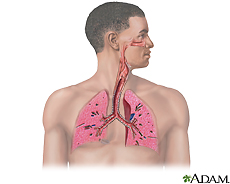 |
 |
 |
Other Health Topics:

-
Related Topics
-
Go Local
- Services and providers for Severe Acute Respiratory Syndrome in the U.S.
-
National Institutes of Health
- The primary NIH organization for research on Severe Acute Respiratory Syndrome is the National Institute of Allergy and Infectious Diseases
Languages
- Chinese - Traditional (繁體中文)
- Japanese (日本語)
- Korean (한국어)
- Spanish (español)
- Vietnamese (Tiếng Việt)
Severe acute respiratory syndrome (SARS) is a respiratory illness caused by a virus. SARS was first reported in Asia in 2003. It spread worldwide over several months before the outbreak ended.
SARS can be life-threatening. Symptoms include
- A high fever
- Headache
- Body aches
- A dry cough
- Pneumonia, later on
SARS seems to spread mainly by close person-to-person contact. When an infected person coughs or sneezes, they send droplets of mucus or saliva that contain the virus through the air. You could get SARS if the droplets land on your mouth, nose or eyes. Kissing, touching, sharing utensils for eating and drinking, or talking with an infected person can also put you at risk. Frequently washing your hands with soap and water might help prevent infection if you travel to countries with SARS. There is no treatment for SARS. Scientists are testing treatments and vaccines.
Centers for Disease Control and Prevention
- Basic Information about SARS(Centers for Disease Control and Prevention)
-
Severe Acute Respiratory Syndrome (SARS)
 (National Institute of Allergy and Infectious Diseases)
(National Institute of Allergy and Infectious Diseases)
| Basics | Learn More | Multimedia & Cool Tools |
|---|---|---|
|
||
| Research | Reference Shelf | For You |
|
-
Overviews
- SARS(Mayo Foundation for Medical Education and Research)
-
Diagnosis/Symptoms
- Severe Acute Respiratory Syndrome (SARS): Laboratory Diagnostic Tests(World Health Organization)
-
Prevention/Screening
- Fact Sheet on Isolation and Quarantine(Centers for Disease Control and Prevention)
- Guidance about Severe Acute Respiratory Syndrome (SARS) for Americans Living Abroad(Centers for Disease Control and Prevention)
- Severe Acute Respiratory Syndrome (SARS) Infection Control(Centers for Disease Control and Prevention)
-
Specific Conditions
- Fact Sheet for SARS Patients and Their Close Contacts(Centers for Disease Control and Prevention)
-
Related Issues
- Advice on SARS and Potential for Food Transmission(Center for Food Safety and Applied Nutrition)
- Questions and Answers on Embargo of Civets(Centers for Disease Control and Prevention)
- SARS Questions and Answers: Travel and Quarantine(Centers for Disease Control and Prevention)
-
Clinical Trials
-
ClinicalTrials.gov: Severe Acute Respiratory Syndrome
 (National Institutes of Health)
(National Institutes of Health)
-
ClinicalTrials.gov: Severe Acute Respiratory Syndrome
-
Journal Articles
References and abstracts from MEDLINE/PubMed (National Library of Medicine)
- Article: Severe acute respiratory syndrome coronavirus 3a protein activates the mitochondrial...
- Article: Construction of a non-infectious SARS coronavirus replicon for application in...
- Article: Certainties and uncertainties facing emerging respiratory infectious diseases: lessons from...
- Severe Acute Respiratory Syndrome -- see more articles
-
Organizations
-
Centers for Disease Control and Prevention
Also available in Spanish
-
National Institute of Allergy and Infectious Diseases

- World Health Organization
-
Centers for Disease Control and Prevention
-
Law and Policy
- Questions and Answers on Legal Authorities for Isolation and Quarantine(Centers for Disease Control and Prevention)
| Home | Health Topics | Drugs & Supplements | Encyclopedia | Dictionary | News | Directories | Other Resources | |
| Copyright | Privacy | Accessibility | Quality Guidelines U.S. National Library of Medicine, 8600 Rockville Pike, Bethesda, MD 20894 National Institutes of Health | Department of Health & Human Services |
Date last updated: 21 August 2008 Topic last reviewed: 20 July 2008 |






